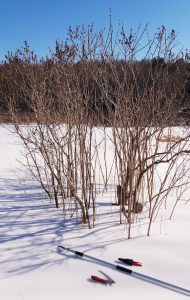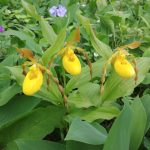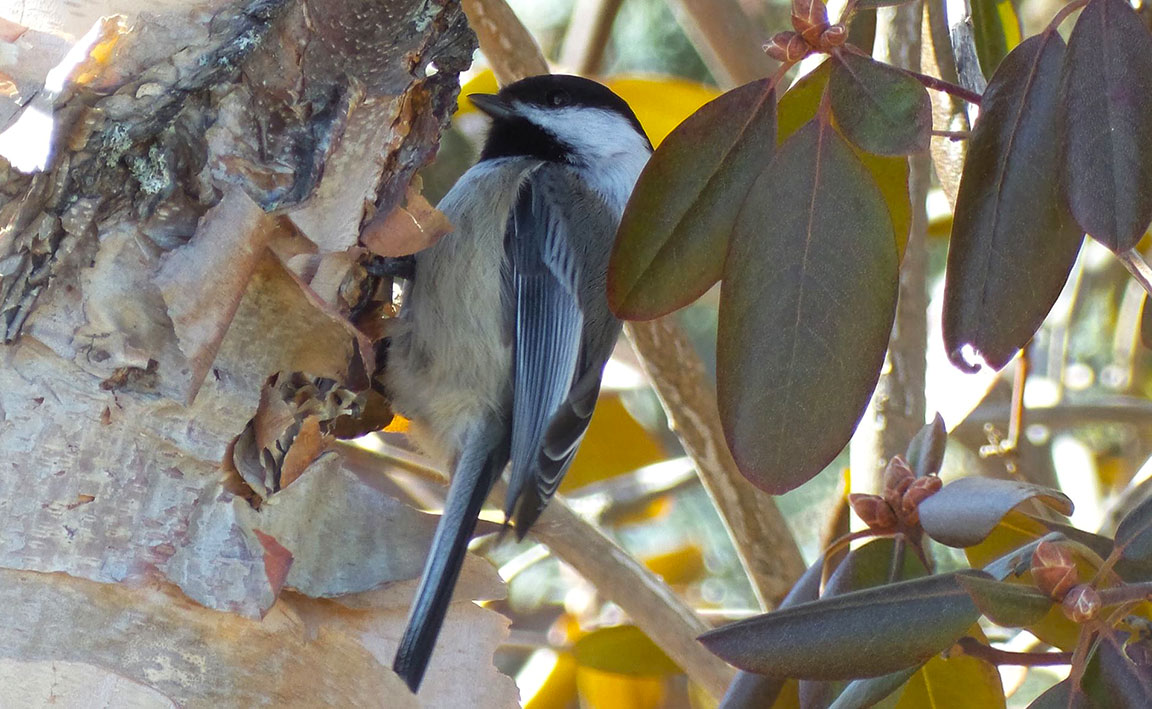
Maine Home Garden News — March 2022
In This Issue:
- March Is the Month to . . .
- Homegrown Nutella? Let Me Introduce You to the American Hazelnut (Corylus americana).
- Seedfolks: 101 fictional pages of how a vacant lot turned garden can impact humanity (Harper Trophy, 1997) by Paul Fleischman
- Basic Steps for Pruning Multi-stemmed Shrubs
- Maine Public Gardens: McLaughlin Garden and Homestead, South Paris, Maine
- Reader’s Exchange
March Is the Month to . . .
By Abi Griffith, UMaine Extension Horticulture Community Education Assistant
- Review garden records or make a record-keeping plan. Do you have garden notes from past seasons? This could be a good time to get a journal or check out these Record-Keeping Tools. Keeping track of gardening activities from year to year can help you select what you want to grow and where, plan what seedlings or seeds you’ll need, and determine when they will need to be started indoors or planted outside. This planting chart for the home vegetable garden could be a good resource as you plan.
- Think about big-picture changes. For those ready to re-assess more significant aspects of your landscape, Bulletin #2701, Designing Your Landscape for Maine is a great resource for overall landscape planning.
- Order your seeds. Once you’ve made your plan, get that order in if you haven’t already! Seed companies have seen a rise in demand with more people growing their own food. We are fortunate to have several excellent seed companies right here in Maine that have varieties well suited for our region. Take a look at Bulletin #2190, Vegetable Varieties for Maine Gardens for suggestions on some reliable varieties tested by researchers at UMaine’s Highmoor Farm.
- Start your own seedlings. See Bulletin #2751, Starting Seeds at Home for information about supplies and growing conditions, which includes a video describing how to make a seedling stand. An easy way to figure out if any of the seedlings you want to grow need to be started in March, go to this website and enter in your last frost-free date (a safe estimate for central Maine is May 25th) and it will provide suggested dates to start your seeds and even information on when your seedlings will be ready to transplant into the garden.
- Prune woody plants. This time of year, you can get a good look at your woody shrubs and trees to determine where branches are crossing, damaged, overgrown with suckers or water sprouts, or generally in need of thinning. Refer to Bulletin #2169, Pruning Woody Landscape Plants for guidance. This bulletin will walk you through the principles and techniques for pruning and it contains helpful video demonstrations. With these constantly fluctuating temperatures, make sure your woody plants are still dormant when you prune and take time to sharpen and clean your tools before you get going.
- Keep learning. Check out the UMaine Cooperative Extension’s Gardening Webinar Series.
- Consider signing up for a Community Supported Agriculture (CSA) share. It’s definitely not too early! Farmers will so appreciate your commitment to them now, while they are very busy starting, planning, and putting a lot into the coming season. Most CSAs have a model that is cost-effective to you, creating a mutually beneficial relationship. Go to Ways to Purchase Maine Products (and scroll down) for more information on debit-style and farmer-select CSA programs.
- At the end of March, get out and sample some local maple syrup. Visit a Maine sugarhouse for the 39th annual Maine Maple Sunday on March 27th for maple syrup sampling, demonstrations, and family-friendly activities!
- Tap your own trees. Refer to Bulletin #7036, How to Tap Trees and Make Maple Syrup for guidance and helpful how-to videos. Forest Trees of Maine can assist you with identifying maple trees on your property in both summer and winter.
- Share resources. The Maine Land Share Project is a new, statewide mutual aid effort to connect people who want to grow food with people who have land to share. This project aims to increase food security while building solidarity through resource sharing.
Homegrown Nutella? Let Me Introduce You to the American Hazelnut (Corylus americana).
By Laloo Meyer, Kennebec County Master Gardener Volunteer

I enjoy growing some of my own food. It’s important to me to grow a few different sources of protein for my diet which neither my veggie garden nor mini fruit tree orchard provides. After observing the land I live on for a couple of years, I saw that I could fit a few small nut trees in the semi-shaded area along the tree line. I generally aim for long-term plantings that require very little maintenance, which almost always translates to a native plant. With all these parameters in mind, the American Hazelnut (also called American Hazel or American Filbert), was the perfect match.
Have you ever tasted Nutella? If yes, then you’ve tasted hazelnuts, although this is made from the European type, which is the common commercial variety. Interestingly, Ferrero, the makers of Nutella, consume 25% of the world’s hazelnut production. The hazelnuts we can buy in the store are European hazelnuts and are all grown in Turkey and Oregon. European hazelnuts are greatly affected by Eastern Filbert Blight (EFB) caused by the fungus Anisogramma anomala, unlike the disease-resistant American hazelnut. The Northern Nut Growers Association (NNGA) has existed for over 100 years and in 1921 documented work of creating a hybrid between the native blight-resistant American hazel and the European hazel. Today there are quite a few hybrids. The American hazel is still the most disease-resistant and cold-hardy of all the hazels, thriving in zones 4-7. It tastes very similar to its European cousin but is a slightly smaller nut, typically measuring half an inch in size.
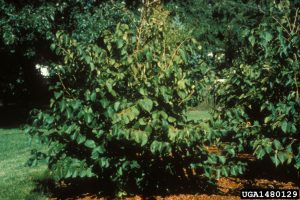
American hazelnut trees can grow as multi-stemmed, rounded shrubs or be pruned into the shape of a small tree. It’s known to grow 12-18 feet tall and 10-15 feet wide. It spreads via rhizomes up to 13 feet from the shrub and sends up suckers. These suckers need to be cut if you are shaping them into a small tree. If left alone they can form a nice thicket. American hazels are also one of the very few trees that can be successfully planted near black walnut as they are able to tolerate juglone, a natural herbicide produced by the black walnut tree. American hazels supposedly prefer well-drained soils but have been demonstrated not to be picky. It is quite pH adaptable, likes full sun or light shade, and is typically found growing in the wild along tree lines. For the most nut production possible, plant in full sun. Basically, the less sun the tree gets, the fewer nuts you get. Hazels are wind-pollinated by male catkins spreading their pollen onto female flowers. Plants have both male and female parts. You will need to plant a few plants in order to get cross-pollination and nut production.
These hazels can experience some minor pest problems (mostly from the nut weevil), but it has no major issues with insects or disease. Once planted the tree’s bark, leaves, and buds will need protection for the first three years until the trees are large enough to not be bothered by any animals (deer, voles, moles, mice). Count on sharing your harvests with the other local hazelnut lovers: squirrels, deer, woodpeckers, turkeys, and pheasants. The male catkins are a food staple of ruffed grouse throughout the winter. To protect my trees I made 6-foot-wide and 5-foot-tall tree cages out of field fencing to place around each of my hazel trees as deer protection, along with 2-foot-wide and 2.5-foot-tall vole cages out of hardware cloth. The vole cages are buried 2-3 inches down into the ground and the snow is stomped down around them after every big snowfall to avoid the winter hungry voles access. The hazels will also need regular weekly watering for their first year until the roots are well established.
The hazels will produce after 3-5 years and give dependable annual yields for 40 to 50 years. Where I’m in zone 5a in central Maine, harvest is usually around September 21st or so. Harvest when the husks turn brown and aren’t sticky anymore. The nuts will form clusters. They are nutrient-dense and protein-rich. They can be roasted, eaten raw, ground into flour, cooked, baked, made into oils and nut butter. You can even try making homemade Nutella!
References:
American hazelnut. The Morton Arboretum. Accessed February 6, 2022.
Corylus americana. Minnesota Wildflowers. Accessed February 6, 2022.
Corylus americana. Missouri Botanical Garden. Accessed February 6, 2022.
Hazelnut Trees Are Easy! Cornell College of Agriculture and Life Sciences Small Farms Program. Accessed February 6, 2022.

Seedfolks: 101 fictional pages of how a vacant lot turned garden can impact humanity. By Paul Fleischman
(Harper Trophy, 1997)
Reviewed by Lynn Snow, 2019 Maine Agriculture in the Classroom Teacher of the Year and 2020 National Excellence in Teaching about Agriculture award recipient.
This book was first brought to my attention when my school followed the Expeditionary Learning model of education. In 2009, together with three colleagues, we took on the challenge of repurposing an abandoned high school ropes course into a school garden. Expeditionary Learning encourages teachers to integrate as many subject areas as possible into a single project. Our project, a school garden, was the perfect place for integration. Seedfolks, an anchor text, has been read in the classroom every year since the garden project began.
The book is written in a format where individual characters offer their perspective with every new chapter. It describes the effects that a garden can have on an individual. Inferences connect the characters without the need to fully develop their personal relationships. It all begins with a 9-year-old Vietnamese girl named Kim who is looking for a way to connect with her deceased father, a man she never had the chance to meet.
Kim’s simple act of planting a few seeds in an opportune location in a vacant city lot attracts attention and eventually leads to creating a community space that cultivates healing, acceptance, friendship, compassion, collaboration, and continuity. The diversity of the characters’ situations allows the reader to experience empathy and gain an understanding of unique circumstances. Furthermore, the story may illustrate the many benefits that gardening has. As the character Nora quotes, “We, like our seeds, are now planted in the garden.”
When I teach the book, Seedfolks, I begin with discussing the author and how the novel evolved. Paul Fleischman was originally going to write a book about first-generation immigrants and title it Seedfolks. However, a newspaper article that mentioned the ancient practice of prescribing garden walks to mentally ill patients, as he describes it, “planted the seed” for how the book’s focus changed.
Typically, I will read aloud each chapter of the book and then use the audio files to allow for a second reading. These files enhance the experience greatly as they are read by a host of narrators that sound like they could truly be the characters themselves. Additionally, kids will have a copy of the text in hand to follow along.
Since I began using this book in the classroom before there was much available curriculum for it, I created my own. I designed character pages where students must visualize, infer, and make predictions for each of the 13 characters. I also designed extension activities to build their knowledge on certain crops, learn about some of the characters’ homelands, and make various book-to-self connections.
 Over the years, I have worked with kids on a number of culminating projects related to Seedfolks. Kids have constructed models of the vacant lot from cardboard boxes, clay, and Legos®. They have created board games, character maps, posters, tri-fold boards, additional chapters (which were shared with Fleischman), and digital presentations. We have planted many of the same crops in our own school garden and named the raised beds after the characters from the book. Seedfolks has inspired students to try vegetables, such as eggplant, in our classroom kitchen because one of the book’s characters grew it and liked it.
Over the years, I have worked with kids on a number of culminating projects related to Seedfolks. Kids have constructed models of the vacant lot from cardboard boxes, clay, and Legos®. They have created board games, character maps, posters, tri-fold boards, additional chapters (which were shared with Fleischman), and digital presentations. We have planted many of the same crops in our own school garden and named the raised beds after the characters from the book. Seedfolks has inspired students to try vegetables, such as eggplant, in our classroom kitchen because one of the book’s characters grew it and liked it.
I haven’t yet, hundreds of students later, found a single kid that has not enjoyed Seedfolks. Whether you’re ten, or ten times that, I recommend this petite, profound novel by Paul Fleischman.
Basic Steps for Pruning Multi-stemmed Shrubs
By Liz Stanley, Horticulture Community Education Assistant UMaine Extension Knox/Lincoln Counties
 Late winter and early spring are ideal times to prune multi-stemmed woody shrubs, even those that flower early. You can easily assess structure, health, and vigor. And with frozen ground, you won’t be disturbing dormant plants and insects as you work.
Late winter and early spring are ideal times to prune multi-stemmed woody shrubs, even those that flower early. You can easily assess structure, health, and vigor. And with frozen ground, you won’t be disturbing dormant plants and insects as you work.
Lilacs and other shrubs such as ninebark, spirea, and red-twig dogwood benefit from periodic pruning. It brings the sun into the canopy for better bud development and improves air circulation to prevent diseases. The lilac in these photos has been renovated gradually over 3 seasons. Old trunks were removed by a third each year and it now produces abundant flowers that are easier to reach. We’re ready for a late winter touch-up.
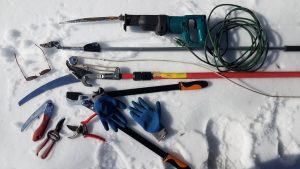 High-quality tools make pruning easy. The basics: hand-held bypass pruner (with a sharpener), pocket saw, and lopper. Shrubs around your house? A reciprocating saw cuts large branches like butter. My favorite tool? A telescoping “birdie,” which cuts pencil-sized suckers without the need to bend over, and spent flowers without a ladder. (Great for removing caterpillar nests.) Don’t forget safety glasses and gloves.
High-quality tools make pruning easy. The basics: hand-held bypass pruner (with a sharpener), pocket saw, and lopper. Shrubs around your house? A reciprocating saw cuts large branches like butter. My favorite tool? A telescoping “birdie,” which cuts pencil-sized suckers without the need to bend over, and spent flowers without a ladder. (Great for removing caterpillar nests.) Don’t forget safety glasses and gloves.
- Step 1: Stand back and look from all angles. Start by removing dead, dying, weak, and crossing branches, and old trunks if needed. Use “thinning” cuts, leaving no unsightly stubs.
- Step 2: Remove most of the suckers from the base. Leave some healthy well-spaced suckers for future trunks.
- Step 3: Remove spent flower clusters, being careful not to cut this season’s large flower buds.
- Step 4: Wait until late May for the flowers!
For more info and videos, visit Bulletin #2169, Pruning Woody Landscape Plants.
Maine Public Gardens: McLaughlin Garden & Homestead, South Paris, Maine
By Corey Kotfila, Horticulturist with McLaughlin Garden & Homestead
The McLaughlin Garden & Homestead is known for its collection of historic lilacs (over 120 varieties), ephemeral wildflowers, and woodland gardens. Sections of the almost three-acre garden are historically designated and still contain many of the same species that were planted there by Bernard McLaughlin, the original owner of the property. No matter what time of year you visit (save for winter), there will always be something blooming. The season starts with impressive displays of trilliums and lady’s slippers and ends with bursts of colors from native wildflowers. The garden also hosts educational lectures, artistic performances, and gardening workshops throughout the season, many of which are free to the public.
The McLaughlin Garden & Homestead was established as a public garden in 1997, but its history goes back much farther than that. It was originally the home of Bernard McLaughin, who inherited the property from his wife’s family in 1936. Soon after taking up residence, Bernard set about transforming the old farming land into a gardening paradise. Despite having no formal training as a horticulturist, Bernard gained notoriety throughout the whole state for his impressive gardens, earning him the unofficial title “Dean of Maine Gardens.”
McLaughlin Garden’s mission is to cultivate a beautiful and healthy environment where discovery, creativity, and connections are nurtured. In order to ensure this mission is accessible to all, the gardens are open year-round and entry is free to the public (with a suggested donation of $5).
- Green textures in garden
- Yellow Lady’s Slipper
- McGlaughlin Garden building
- Lilium Superbum
- Lilac In the sunlight
For more information, see McGlaughlin Garden & Homestead.
Maine is adorned with countless public gardens in nearly every corner of the state. They’re a source not only of beauty but of inspiration and peace. Keep an eye out for tributes to these botanical treasures in future issues of the Maine Home Garden News, and reach out to us to nominate your own favorite public garden.
Reader’s Exchange
I live near the coast and we get a lot of wind. After every windy day, there are sticks on my lawn. I use a long-handled grabber to pick them up. It allows me to clean the lawn without bending over. The grabbers pick up even big sticks. Some of the smaller ones take a try or two, but it saves my back. I can stroll around my yard talking on the phone while picking up sticks or carrying a bucket to hold them.
For an example (no endorsement intended), see Amazon.com: Ettore Grip’n Grab: Multi-Purpose Reach Tool with Rotating Rubber Grip Head: Health & Household
Thanks,
S. Olson
Our readers have a lot of experience and great ideas. Therefore, we decided it’s high time you chimed in with some of your favorite gardening tips and tricks. Each month, we’re challenging you to send us gardening “hacks” that make your horticultural life more fun and productive. If your submission is selected, we’ll provide you with a free soil test with the Maine Soil Testing Service. Submit your ideas to katherine.garland@maine.edu with the email subject “Reader Exchange”.
Do you appreciate the work we are doing?
Consider making a contribution to the Maine Master Gardener Development Fund. Your dollars will support and expand Master Gardener Volunteer community outreach across Maine.
Your feedback is important to us!
We appreciate your feedback and ideas for future Maine Home Garden News topics. We look forward to sharing new information and inspiration in future issues.
Subscribe to Maine Home Garden News
Let us know if you would like to be notified when new issues are posted. To receive e-mail notifications, click on the Subscribe button below.
University of Maine Cooperative Extension’s Maine Home Garden News is designed to equip home gardeners with practical, timely information.
For more information or questions, contact Kate Garland at katherine.garland@maine.edu or 1.800.287.1485 (in Maine).
Visit our Archives to see past issues.
Maine Home Garden News was created in response to a continued increase in requests for information on gardening and includes timely and seasonal tips, as well as research-based articles on all aspects of gardening. Articles are written by UMaine Extension specialists, educators, and horticulture professionals, as well as Master Gardener Volunteers from around Maine, with Katherine Garland, UMaine Extension Horticulturalist in Penobscot County, serving as editor. Special thanks to our Master Gardener Volunteer co-editors Naomi Jacobs and Abby Zelz.
Information in this publication is provided purely for educational purposes. No responsibility is assumed for any problems associated with the use of products or services mentioned. No endorsement of products or companies is intended, nor is criticism of unnamed products or companies implied.
© 2022
Call 800.287.0274 (in Maine), or 207.581.3188, for information on publications and program offerings from University of Maine Cooperative Extension, or visit extension.umaine.edu.
The University of Maine is an EEO/AA employer, and does not discriminate on the grounds of race, color, religion, sex, sexual orientation, transgender status, gender expression, national origin, citizenship status, age, disability, genetic information or veteran’s status in employment, education, and all other programs and activities. The following person has been designated to handle inquiries regarding non-discrimination policies: Director of Equal Opportunity, 101 North Stevens Hall, University of Maine, Orono, ME 04469-5754, 207.581.1226, TTY 711 (Maine Relay System).

